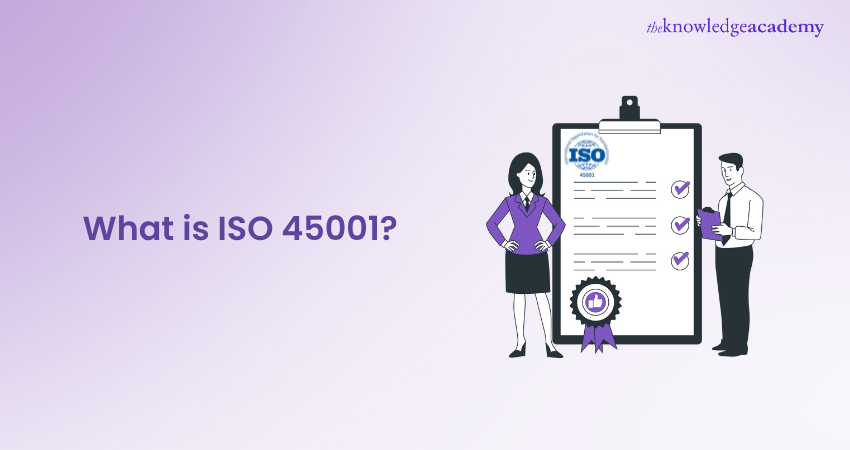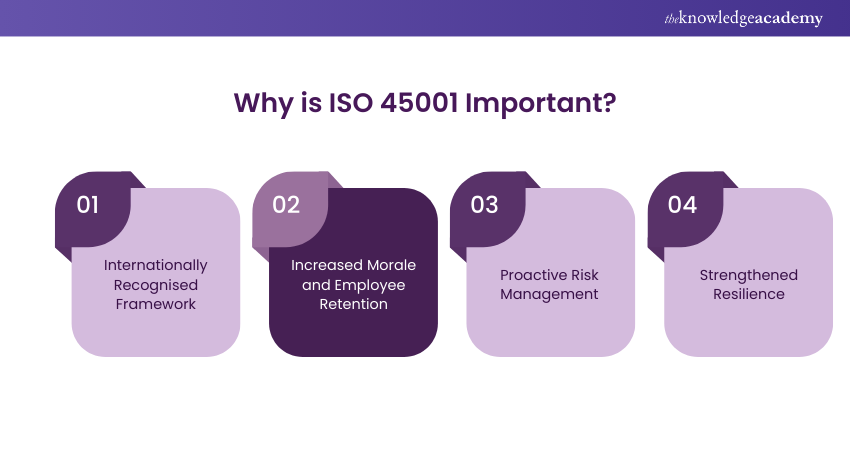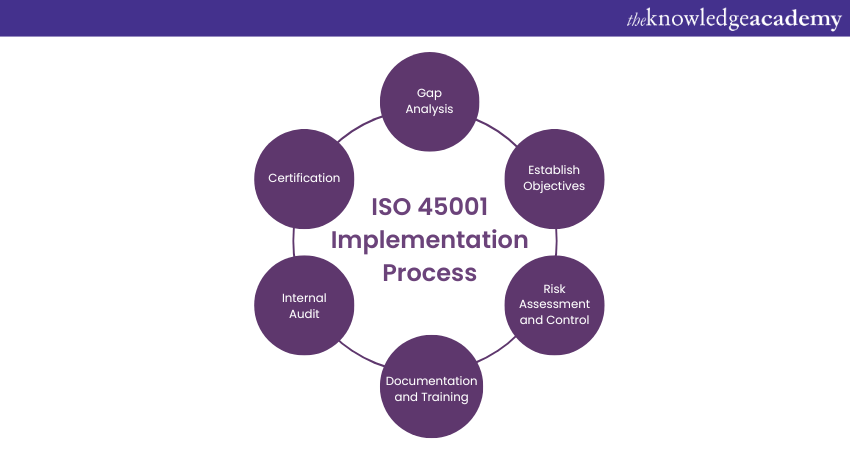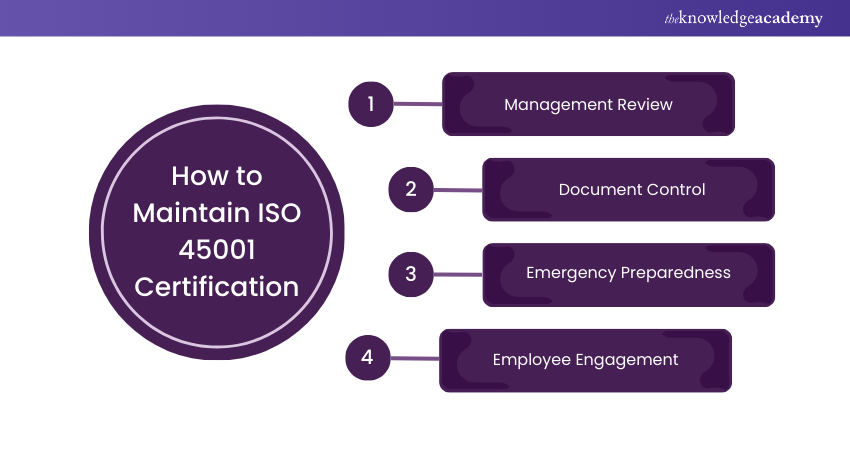We may not have the course you’re looking for. If you enquire or give us a call on +34 932716793 and speak to our training experts, we may still be able to help with your training requirements.
Training Outcomes Within Your Budget!
We ensure quality, budget-alignment, and timely delivery by our expert instructors.

ISO 45001 is a global standard that has a sturdy system which makes it easier for businesses to identify the hazards, mitigate risks, and incorporate an effective safety culture. Be it for you an ISO 45001 beginner or an experienced user, all you need is to read our blog and enjoy it.
This post provides the information you need to know about what ISO 45001 is, its key characteristics, and the procedures of how to achieve and maintain your ISO 45001 certification. Read along as this blog uncover the essential principles for establishing a safer and healthier workplace.
Table of Contents
1) What is ISO 45001?
2) Origins of ISO 45001
3) ISO 45001 Fundamentals
4) Why is ISO 45001 Important?
5) Key Benefits of ISO 45001 OHSAS Certification
6) How to get Certified to ISO 45001?
7) ISO 45001 Implementation Process
8) Maintaining ISO 45001 Certification
9) Is ISO 45001 Certification Necessary ?
10) Conclusion
What is ISO 45001?
ISO 45001 is a protocol developed by the International Organisation for Standardisation (ISO) and has gained a global recognition. It gives a structure for administrations to use for the risks that result from occupational health and safety and make the workplaces much safer. The standard emphasises using preventive measures to be able to predict accidents and to enforce the employee health.
In addition to this, the standard suggests that the company should develop the Occupational Health and Safety (OH&S) policy. Moreover, it demonstrates standards for objective programming, execution, auditing, and reporting.
The essential components include senior leadership commitment and active participation. Additionally, recognising hazards, evaluating risks, and adhering to legal guidelines are crucial. Being prepared for emergencies, investigating causes, and continuously improving are also vital.
The significance of the ‘Plan-Do-Check-Act’ methodology in the implementation of the ISO 45001 framework is to provide health and safety risks’ mitigation approach. In general, it may be implemented by organisations of different sizes and it can be made a part of a generic ISO management system.
Origins of ISO 45001
ISO 45001, known as "Occupational Health and Safety Management Systems – Requirements with Guidance for Use," is an international standard that instructs the management of occupational health and safety. Released in 2018, it replaced OHSAS 18001:2007.
Prior to creating the standard, a "Justification Study" emphasised the importance of improved alignment of management system standards and their integration with current systems. This resulted in the development of the "High Level Structure" (Annex SL), which harmonises the structure and language used in management systems.
The 2011 OHSAS Project Group survey found more than 90,000 certificates across 127 countries, highlighting the need for ISO standards in the industry. ISO 45001 has the goal of:
a) Make sure that work environments are safe and healthy
b) Apply to organisations of all sizes and types worldwide
c) Adjust to different levels of organisational maturity and circumstances
d) Outline essential elements of an occupational Health and Safety Management system
e) Promote compliance, mitigate risks, and enhance performance
f) Harmonise with other standards, specifically ISO 14001 for managing environmental aspects
ISO 45001 Fundamentals
ISO 45001:2018 replaces the previous standard, OHSAS 18001, and serves as the international ISO standard for Occupational Health and Safety Management Systems (OHSMS). Notably, ISO 45001 simplifies integration with other management systems by sharing the common structure defined by Annex SL.
Moreover, it aligns directly with the 2015 versions of ISO 9001 and ISO 14001. For more details and a comparison to OHSAS 18001, refer to the NQA ISO 45001 Gap Guide. Existing NQA OHSAS 18001 clients can access migration support and download the gap analysis document required prior to a migration audit.
Achieve excellence in Occupational Health and Safety with our ISO 45001 Course – Register now!
Why is ISO 45001 Important?
The deployment of the ISO 45001 Standard will result to organisational benefits, particularly if you are interested in the areas of health and safety hazards control or accident prevention. The implementing safety and health at the workplace will then give the organisation the opportunity to demonstrate their commitment to the OH&S. The benefits of the standard’s implementation include the following:

a) Internationally Recognised Framework: ISO 45001 is a recognised standard which helps companies to manage and control their occupational health & safety risks. It is developed to meet the expectations of organisation in their systematic evaluation of workplace hazards. Additionally, they can also use this framework as a guiding tool to implement the risk control measures. These measures by organisations contribute largely to a substantial decrease in workplace injuries, sickness and accident rate.
b) Increased Morale and Employee Retention: This standard provides a guiding framework for organisations that express their commitment towards the health and safety of their workers through the adoption of ISO 45001. Therefore, it is a major factor for enhancing their mental health and, additionally, their mood and morale at the workplace.
c) Proactive Risk Management: To be proactive when it comes to risk management, organisations should implement and fully comply with the ISO 45001 standards. As it makes sure you can identify and mitigate risks early on in the process.
d) Strengthened Resilience: The ISO 45001 framework makes sure that organisations prepare themselves in case of emergencies and response protocols. This secures all employees against potential safety threats and crises situations that may occur. Level up your occupational health and safety skills with our – sign up now!
Key Benefits of ISO 45001 OHSAS Certification
Implementing ISO 45001 provides you a range of benefits for your organisations and their employees. Let's explore the key advantages of adopting this standard in your practice:
1) Enhanced Employee Safety: ISO 45001 main priority is the wellbeing of the employees. It uses a proactive approach to identify and assess risks. It further helps have a plan of action ready to mitigate such hazardous situations reducing the likeliness of injuries and other health risks.
2) Legal Compliance: Organisations are legally obligated to comply with occupational health and safety regulations. ISO 45001 assists businesses to meet the legal demands through its framework which is consistent with the laws and regulations at play. The implementation of the standard allows organisations to reduce legal risks, avoid fines, and maintain a good reputation.
3) Improved Productivity: A healthy workspace that is well-kept boosts productivity. Organisations are urged by the ISO 45001 standard to develop control systems and take preventive actions that in turn reduce the number of accidents and injuries. This eventually minimises the absenteeism, downtime, and disruptions to operations.
4) Enhanced Organisational Reputation: The ISO 45001 Certification highlights the organisation's willingness to ensure safety in workplaces, both inside and out. It tells the stakeholders, customers, and partners that the organisation appreciates employee welfare and acts with ethical standards. That can improve the image of the organisation, capture clients who are safety-conscious and provide a competitive advantage in the market.
5) Reduced Costs: Capital investment in safety and health measures could help to save on costs in the future. Through the prevention of accidents and occupational diseases, organisations will be able to reduce medical bills, compensation costs, insurance premiums, and expenses incurred from downtime and production stops.
6) Continuous Improvement: ISO 45001 helps create a system of constant development within the organisation. Through constant review of the efficacy of the health and safety management system. This facilitates organisations in identifying the areas of improvement & prescribing corrective measures accordingly. This ahead-of-the-game approach provides organisations with the ability to detect potential risks before they occur, respond promptly to changing situations, and keep improving their health and safety.
7) Supply Chain Benefits: ISO 45001 certification can also have positive effects on the supply chain. When organisations prioritise occupational health and safety, it encourages suppliers and partners to adopt similar practices. This creates a ripple effect of improved safety standards throughout the supply chain, ensuring a safer working environment for all involved.
Learn to Audit Management system with our ISO 45001 Lead Auditor Course – Sign up now!
How to get Certified to ISO 45001?
If you are looking to get certified with the ISO 45001, and you don’t know how. Don’t worry it's a simple procure consisting of three easy steps. And this blog will guide you through it. Here are the three easy steps for you to follow if you wish to get certified:
1) Step 1
Fill up the Quote request form available on the Global Certification Body (NQA) website for them to prepare a personalised proposal for your certification and define your scope of assessment.
2) Step 2
You will then be contacted by the NQA assessor, and will need to comply with two mandatory visits from the Internal Certification Audits. Note: You need to be able to demonstrate your management system being operational for at least 3 months, and that it has been subjected to a management review as well as a full cycle of internal audits.
3) Step 3
Once the audits are completed successfully. A decision will be made based on the findings of the audit. If it is positively in your favour, the NQA will issue you the certification, in the form of both a soft and hard copy. Note: This certification is held valid only for three years and will need to be maintained by surveillance audits in the end of year one and two and a third at the end of the third year for certification renewal if you wish to continue to hold the certification.
ISO 45001 Implementation Process
Implementing ISO 45001 requires careful planning and execution. This section outlines the general steps involved in adopting the standard:

1) Gap Analysis: A complete assessment of your current occupational health and safety practices to identify gaps and areas for improvement.
2) Establish Objectives: Specific goals for your organisation's health and safety performance and define measurable targets to monitor progress.
3) Risk Assessment and Control: Identification of potential hazards and associated risks. Followed by effective implementation of control measures to eliminate or minimise these risks.
4) Documentation and Training: Development of necessary documentation, including policies, procedures, and work instructions. A provision of comprehensive training to employees to ensure their understanding and compliance with the safety regulations.
5) Internal Audit: Conduct regular internal audits to assess the efficiency of your occupational health and safety management system. Address any non-conformities and continually improve your processes.
6) Certification: Engage an accredited certification body to audit your system and award ISO 45001 certification upon successful verification of compliance.
Maintaining ISO 45001 Certification
ISO 45001 certification is not a one-time achievement; it requires ongoing commitment and continuous improvement. This section highlights key aspects of maintaining certification, such as:

1) Management Review: Conduct periodic reviews of your health and safety management system at the management level. Evaluate performance, review objectives, and implement necessary improvements.
2) Document Control: Ensure proper control and management of documents and records related to occupational health and safety.
3) Emergency Preparedness: Establish procedures to effectively respond to emergencies and minimise potential risks during critical situations.
4) Employee Engagement: Involve employees at all levels in health and safety initiatives. Encourage feedback, suggestions, and active participation to foster a culture of safety.
Is ISO 45001 Certification Necessary?
ISO 45001 certification is essential if you currently hold certification to OHSAS 18001. To maintain the validity of your certification, you’ll need to migrate to ISO 45001. Fortunately, there’s a normal three-year migration period, allowing ample time to plan your transition.
ISO 45001 is the right choice if you and your organisation are committed to managing the safety of workers and other interested parties. If you’ve already implemented a quality or environmental management system aligned with the Annex SL structure, integrating ISO 45001 will be seamless. Key requirements for organisations implementing ISO 45001 include:
a) Clear management structure with defined authority and responsibility.
b) Objectives for improvement, with measurable results.
c) A structured approach to risk assessment and reduction.
Regular monitoring of health and safety management failures, performance, and review of policies and objectives to ensure continuous improvements and business benefits.
Remember, ISO 45001 provides a robust framework for enhancing workplace safety and well-being
Conclusion
In this blog we see, What is ISO 45001 and how it serves as a vital tool for organisations to improve occupational health and safety practices, protect their employees, and achieve sustainable business growth. You gain insights on how implementing this standard, organisations can create safer work environments, comply with legal requirements, and gain a competitive advantage. Additionally, we discussed how you can avail and maintain your certification as well.
Start your journey to a safer workplace with ISO 45001 Foundation Certification. Enroll today!
Frequently Asked Questions

Incorporating an Occupational Health and Safety (OH&S) Management system requires ISO 45001, applicable to businesses of all sizes, especially in high-risk sectors like construction, manufacturing, oil and gas, and mining. It helps control risks, reduce incidents, and demonstrate commitment to employee health and safety.

The ISO 45001 standard defines the framework for a system managing occupational Health and Safety (OH&S). It is made up of ten clauses, which include context analysis, leadership, worker participation, and planning. These statements offer a solid structure for companies to handle risks, enhance OH&S results, and guarantee adherence.

ISO 45001 differs by focusing on the company's relationship with its environment, unlike OHSAS 18001, which handles internal risks. It emphasises process-based, proactive risk evaluation, continual improvement, and legal compliance, and integrates easily with other ISO standards.

The Knowledge Academy takes global learning to new heights, offering over 30,000 online courses across 490+ locations in 220 countries. This expansive reach ensures accessibility and convenience for learners worldwide.
Alongside our diverse Online Course Catalogue, encompassing 17 major categories, we go the extra mile by providing a plethora of free educational Online Resources like News updates, Blogs, videos, webinars, and interview questions. Tailoring learning experiences further, professionals can maximise value with customisable Course Bundles of TKA.

The Knowledge Academy’s Knowledge Pass, a prepaid voucher, adds another layer of flexibility, allowing course bookings over a 12-month period. Join us on a journey where education knows no bounds.

The Knowledge Academy offers various ISO 45001 Certification, including ISO 45001 Foundation, ISO 45001 Lead Auditor, ISO 45001 Internal Auditor and ISO 45001 Lead Implementer. These courses cater to different skill levels, providing comprehensive insights into What is ISO.
Our ISO & Compliance Blogs cover a range of topics related to ISO, offering valuable resources, best practices, and industry insights. Whether you are a beginner or looking to advance your ISO & Compliance skills, The Knowledge Academy's diverse courses and informative blogs have got you covered.
Upcoming Health & Safety Resources Batches & Dates
Date
 ISO 45001 Foundation
ISO 45001 Foundation
Mon 10th Feb 2025
Mon 19th May 2025
Mon 8th Sep 2025
Mon 8th Dec 2025







 Top Rated Course
Top Rated Course



 If you wish to make any changes to your course, please
If you wish to make any changes to your course, please


